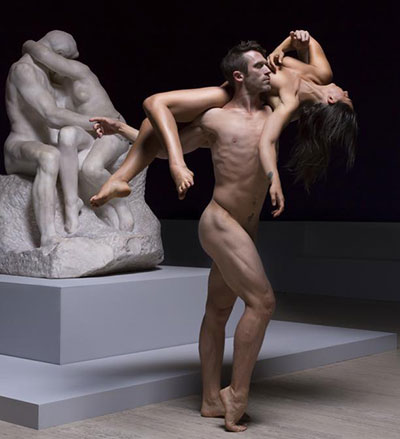McAllister brings up an interesting point about the way dance marketing has become increasingly raunchy in the past 15 years in response to an increasingly sexualised culture. His personal guiding rule is “if it can’t be in the show, it can’t be on the poster … otherwise it’s misleading people”.
So, what do dancers think of nudity? You would imagine that most would be fine — incidentally, they are paid a so-called nudity loading for their efforts — but a surprising number admit to discomfort, at least initially. Li still recalls his nerves at going almost completely bare, save for a dance belt, in The Rite of Spring (“I had to imagine I was a wild animal”).
Van Dijk, meanwhile, winces at the memory of being asked to perform nude for the first time at 19 as a young dancer in Rotterdam, but says “it’s like jumping into water with no clothes on — you get used to it”.
Some don’t, as was the case when former AB principal Justine Summers refused to dance in Bella Figura. (She would later say, “I don’t want to be remembered for the tits. I want to be remembered as a dancer.”)
SDC dancer David Mack has taken part in “extreme” performances with the de Frutos company in the past but says he still has times in the studio when he has qualms about baring all, depending on headspace or mood.
Young recruit Carroll says he was “definitely” hesitant when first approached for Nude Live — it seemed premature for only his second ever mainstage show with SDC — but took the approach “that I may as well do it now while my body is still young”.
For male dancers, nudity can trigger anything from body image issues — men, too, sometimes have “fat days”, says Mack — to “a real anxiety around penis size”, as Stewart puts it.
But when it comes to the sexual politics of nudity, female dancers are more likely to be put in potentially awkward situations, McAllister believes: “It can seem more gratuitous … often male choreographers seem to be more interested in talking the girls into getting out of their gear than the boys.”
Micich agrees that choreography tends to still be a “male-driven industry”.
When audiences head to AGNSW to watch the SDC dancers next month, be warned — they might be watching you. “I think there’s always an interesting reaction to observe when people go see a nude show,” says Mack. “We all go through this spectrum of voyeurism, a bit of shame, embarrassment. How long do you look for, and will you be judged for looking?”
Nude Live is at the Art Gallery of NSW from January 7 to 23.

 Xavier Le Roy's Temporary Title at Sydney's Carriageworks.
Xavier Le Roy's Temporary Title at Sydney's Carriageworks.
Custom HTML Preview
Huh. I guess there will always be an audience who are fixated on seeing dangly-bits on the stage, or the beach. The novelty will wear off and the artists will tire of the, er, exposure. (I wonder how good it will look on one's CV?)
We survived Oh! Calcutta an Number 96 without the sky falling in.
Just ignore it and it will all pass soon enough.
More tax payers money down the drain and for what?
A chance for some art types to perve at naked people.
It would be cheaper and less intrusive on society to just buy them all a subscription to playboy.
Ask yourself how this would be done if it had to make money or at least break even?
It takes codswallop to new heights of insufferability. Without artistic guidance and support, there are some parts of the anatomy that don't stop with the music. Dear, dear .... only amongst the self congratulatory cognoscenti in Sydney.
Well, the music is great regardless.
I bet they all vote Labor/Greens...
@Paul Oh, give it a miss, mate. What a totally unlikely and unnecessary comment. #
If the trend is back to the 1980s and earlier then the current "fashion" of shaved pubic hair presumably will also not be adopted by the dancers.
Au naturel? Let's hope so.
Good memories of " Hair ".
Sounds about as appalling as having to endure a strippergram event.
Mrs Trev
From the comments below I guess you would all prefer that burkas and burkinis were legislated as compulsory for any women leaving their residence and men wear flowing Arabic robes. Grow up and appreciate talent.
Me , my mates and girlfriends are just finishing up a Boozy party at Bondi.
We have all decided to go to the Art Gallery, strip off our clothes and stagger around the place pretending to be artistic!
I'm assuming we won't be arrested given that it's art and all that.
We'll be there in about an Hour.
Deplorable No. 1
@Greg rats if I had got to this earlier we would have rushed in to cheer you on. Given our age we wouldn't have joined you though.
Nothing like a bit of live porn to get the crowd going, hey?
So this is art is it? Gove me my tax back.
Robert Helpmann was correct in his comments on nude dancing. A flopping penis going in one direction whilst the testicles go in another detracts from the gracefulness of ballet. If people want crude nudity there are any number of pole dancing venues or the like available.
gimmick
This comment has been deleted
I agree with the amazing and peerless Li Cunxin. It has to be essential to the narrative, or it becomes exhibitionism and a distraction. Hopefully, it is going to be relevant and not irreverent.
This comment has been deleted
Narcissistic self indulgence.
@Shane Shane on you, let them be.
@Shane Put it away, please.